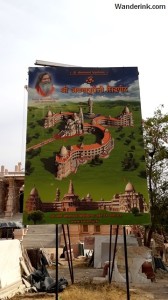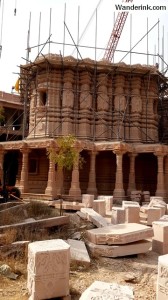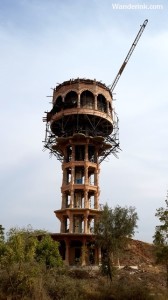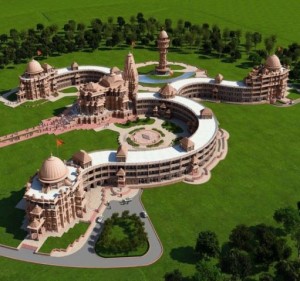Jadan would have passed by like any other town in rustic Rajasthan during midday – an ochreous vastness permeating in all directions, including upwards, which turns out to be buildings as you get closer – if it weren’t for Dipu who was with me to take the car, lent by my gracious host the Thakur of Auwa, back to Auwa.
“I’m sure you will love it.” Dipu said. Since he had been on the phone with his girlfriend from the time we left, on the phone even when he occasionally turned towards me to give directions – I was driving – or to point out the sights, I wasn’t sure he was talking to me.
“Here, we have to turn here.” He said which obviously was meant for me for now he was cupping the mouthpiece of his smartphone, the palm arced around it without touching. After bouncing over a non-existent service lane by a side road that was being laid in bits and parts, we reached a leviathan wrought iron gate with trishul-shaped finials, a man-size wall spanning in both directions in a wide serpentine arch, glass shrapnel reflecting jagged sunlight off the top. Heat waves heaved up from the guardhouse cowering near the imposing safety measures drawing patterns in the air. A guard sauntered out; you could actually see his energy ebbing in the zapping afternoon sun, leaving a trail on the smouldering, scraping sand. He dragged himself to our car and announced with a stirring vigour that nobody was allowed within the premises without permission.
“Whose permission?” The croak from my parched throat might have gone off like an impudent bark for the guard turned and started to walk away ignoring me. Dipu got out of the car and spoke to him; I snatched plenty of ‘thakur’ in whatever Dipu was telling him. Thus procuring the necessary permissions we were allowed to proceed on foot.
From a distance it struck me like a fancy period-themed billion-dollar casino coming up in Las Vegas – in the Mojave, to be precise. Must be the similar geographies. Tower cranes boomed high over the colonnades of the frontispiece, cables still hooked on to the recently placed ones. Perfectly cut out boulders of sandstone lay strewn about leading to a makeshift masonry workshop draped with a chalky white stone-mote curtain under a tautly pulled tarpaulin. Though the seemingly interminable walk had drained me of my energies, the anticipatory splendour wrung out an appreciative sigh. This was history in the making, grandeur tailor-made for posterity. Immortalising the age. Our age. Epithets would be waiting to be sprung: Jewel of Jaden? Eighth World Wonder? The second one might be a tad too ambitious especially when parallels are prone to be drawn with the Taj Mahal. But C. Lakshman, the manager on site, a retired defence personnel, doesn’t shy away from comparisons with the world wonder.
“The Taj is a wonderful historic monument, an architectural marvel.” He vouches before adding, “But it is a mausoleum. The Om Ashram, on the other hand, will be a tribute to living, to life, to global peace and harmony.”
The Ashram coming up in 250 acres is the largest construction in the world shaped in the form of the sacred Sanskrit chant ‘OM’ – the mantra which represents wholeness, the all-encompassing mystical entity, which contains the three fundamental aspects of god as the Creator (Brahma), the Sustainer (Vishnu) and the Liberator (Shiva). It is sacred not just in Hinduism but is held holy in Buddhism and Jainism as well. The Om Ashram will feature 108 residential apartments (108 is a number revered in Hinduism as there are 108 rudraksha beads in the japa mala), the bindu or the point of the crescent moon in the Om layout will be a tower 108 feet high housing a dozen temples. The water supply tank is coming up on a framework 90 feet tall which will have a Surya Temple dedicated to Sun God above it. All the constructions in and around the Ashram are as per the ancient scientific treatise, the Vaastu Shastra. In addition to Vedic studies, the Om Ashram will also promote yoga, specifically ‘Yoga in Daily Life’ developed by Swami Maheshwarananda.
Swami Maheshwarananda may not be a household name in India like Baba Ramdev or Sri Sri Ravi Shankar but the Swami – and his branch of yoga – is an ever-growing cult internationally. The humaneness in approach and an inherent broadmindedness in thought are the pivotal lures of his philosophy. His teachings thus centre around tolerance for all religions, culture and nationalities, protection of human rights and values, preservation of environment and conservation of wildlife and in promoting world peace. His ‘Yoga in Daily Life’ developed with doctors, physiotherapists and psychologists is a comprehensive system aimed at physical, mental, social and spiritual health. ‘Yoga is not a part of any religion but all religions are part of yoga,’ the Swami propounds. An advanced practitioner of this stream of yoga can even control the Vrittis, basically disturbances emanating from the mind, through which there is a better grip on everyday emotions like pain, sorrow and heartbreak. No surprise ‘Yoga in Daily Life’ has millions of followers spread over 3,500 centres all over the world.
The Om Ashram at Jaden – hometown of Swami Maheshwarananda – will be among the largest ashrams dedicated to this branch of yoga and will provide residential facilities to over 500 students and practitioners at any time. Work has been going on for nearly 20 years now and Lakshman says it will take another 6 – 7 years more. More than 300 artists and craftsmen from all over India are bent over, sieving scarfs over faces, chipping away with their chisels, trowels and hammers, brushing away the fine dust and running a practised finger to test the smoothness of the petal or the roundness of the carved ghantas. The elaborately ornate pillars feature fluted motifs with strong spiritual undercurrents and inspired by world religions. Inside the cupolas reverberate with the hum of stone-studded blades of mechanised stonecutters; more craftsmen are perched on girders giving final touches to a foliate inlay that wraps its way around cornices and columns. The intricate perfection of the jaali – mesh work – covering the windows is at par with what we see in the tomb of Salim Chisthi in Fatehpur Sikri or the Hawa Mahal in Jaipur.
“The Ashram’s work has in a way revived the flagging fortunes of these immensely talented artists who would have been otherwise forced to find work in one of your Delhi flyovers or Gurgaon malls.” Lakshman pointed out with a straight face, his eyes giving away amusement.
“Yet another reason I loved the Om Ashram.” I told Dipu back in the car.

















Pretty impressive but not very cosy. Not the type of Ashram I would go to.
Maybe you should wait till the construction is over? Anyway ashrams are supposed to be ‘cosy’… 🙂